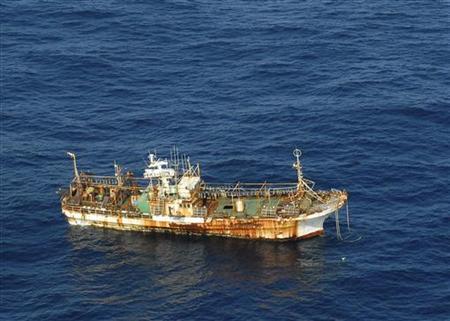Alaskan Crews Gear Up To Tackle Japan Tsunami Debris
Date: 28-May-12
Country: ALASKA
Author: Yereth Rosen

The unmanned Japanese fishing vessel, Ryou-un Maru, drifts northwest
approximately 164 miles southwest of Baranof Island, in the Gulf of
Alaska, in this U.S. Coast Guard handout photo from April 4, 2012.
Photo: U.S. Coast Guard/Petty Officer 1st Class Sara Francis/Handout
Cleanup workers will soon attack a jumble of debris from Japan's 2011 tsunami that litters an Alaskan island, as residents in the state gear up to scour their shores for everything from buoys to building material that has floated across the Pacific.
The cleansing project slated to start on Friday on Montague Island is expected to last a couple weeks, and organizers say it marks the first major project in Alaska to collect and dispose of debris from the tsunami.
The March 2011 tsunami, caused by a magnitude 9.0 earthquake, killed nearly 16,000 people and left over 3,000 missing on Japan's main island of Honshu, and precipitated a major radiation release at the Fukushima Daiichi nuclear plant.
A U.S. senator has sought to obtain $45 million to tackle the problem, and officials have cited fears about invasive species and toxic substances thought to be among the floating mess of objects.
While debris from Japan is also floating toward other U.S. states along the West Coast, Alaska has a more extensive shoreline, much of it difficult to reach.
Montague is an uninhabited island at the entrance to Prince William Sound, southeast of Anchorage. About a dozen volunteers and employees from the environmental group Gulf of Alaska Keeper and the Center for Alaskan Coastal Studies will handle the debris-removal project at the island.
"We'll probably remove 30 to 40 tons from there. That's just a start," said Patrick Chandler, special programs coordinator for the Center for Alaskan Coastal Studies.
Japan has estimated 5 million tons of debris was swept out to sea, but that most of it sank, leaving 1.5 million tons floating. Still, those figures are rough estimates, said the National Oceanic and Atmospheric Administration.
POLYSTYRENE FOAM 'EGGS'
Observers flying over the Alaska coast have spotted, among other items, huge numbers of barrel-sized polystyrene foam buoys, often associated with Japanese oyster farms.
Tiny specks of polystyrene foam that break away from larger objects can be dangerous to seabirds or marine mammals, because they resemble eggs or other food morsels, Chandler said.
Another worry is that floating debris might carry invasive species, such as barnacles, that would wreak havoc in waters off Alaska and the U.S. West Coast, said Doug Helton, the Seattle-based coordinator of NOAA's office of response and restoration.
Then there is the danger from noxious substances in partly full fuel jugs, cleanup organizers said.
Last month, the U.S. Coast Guard sank a 164-foot fishing boat from the Japan tsunami that drifted near Alaska. The Coast Guard said the so-called "ghost ship" was a navigational hazard.
With more debris headed for the West Coast, questions about cleanup costs remain unanswered. Those expenses could be high in Alaska because of geographic and weather challenges.
U.S. Senator Mark Begich of Alaska suggested last week that NOAA provide $45 million as an initial outlay to fund what is expected to be a sustained and difficult beach cleanup.
Meanwhile, David Baxter, a technician who works at a Federal Aviation Administration station on the uninhabited Middleton Island in the Gulf of Alaska, has made some notable finds on his rounds in his hobby of beachcombing.
Earlier this month, the owner of a tsunami-wrecked restaurant in the coastal Miyagi Prefecture spotted one of her buoys among Baxter's debris photos posted online. The yellow buoy was part of the restaurant's sign, he said.
Baxter has arranged to send it back to the woman. "Now that her buoy's found, she's going to rebuild," he said.
(Editing by Alex Dobuzinskis and Todd Eastham)
![]()
© Thomson Reuters 2012 All rights reserved